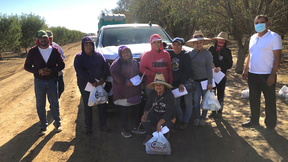Two LLNL scientists selected as 2023 American Physical Society fellows
 (Download Image)
(Download Image)
LLNL's Ibo Matthews and Frank Graziani have been selected as 2023 American Physical Society fellows.
Lawrence Livermore National Laboratory (LLNL) scientists Manyalibo “Ibo” Matthews and Frank Graziani have been named 2023 American Physical Society (APS) fellows.
Matthews was selected from the Forum in Industrial and Applied Physics unit “for pioneering research in optimizing metal 3D printing and laser materials processing.”
Frank Graziani was chosen from the Division of Plasma Physics unit, “for original theoretical and computational contributions on the frontiers of fundamental properties of non-ideal plasmas, and for exceptional leadership in the national boost initiative, including mentoring and educating the broader high energy density physics community.”
The APS Fellowship Program was created to recognize members who may have made advances in physics through original research and publication, or made significant innovative contributions in the application of physics to science and technology. They also may have made significant contributions to the teaching of physics or service and participation in the activities of the society.
Fellowship is a distinct honor signifying recognition by one's professional peers. Each year, no more than one half of 1% of the society’s membership (excluding student members) is recognized by their peers for election to the status of fellow of the American Physical Society.
Frank Graziani
Graziani has had an evolving career during his 34 years at the Lab. He started off interested in the fundamental understanding of burn physics and finding a better way to validate physics models used in radiation-hydrodynamics codes. He then became interested in non-ideal plasmas or warm dense matter. Five years ago, he looked into quantum computing and never looked back.
“I fell in love with the field. It is extremely challenging, but it holds so much promise for the future,” he said.
He thanked his students, postdocs and colleagues for credit in being selected as an APS fellow.
“Being named a fellow of the American Physical Society was a tremendous honor,” he said. “This honor is a testimony to all of the brilliant students, postdocs and scientists who I have worked with over my 34 years at LLNL. Science, especially the type of big science we do at the national laboratories, is a community affair. In pursuing the science I am passionate about, I am fortunate enough to have a network of colleagues around the world who I also count as my friends.”
Graziani now serves as the director of the High Energy Density (HED) Science Center at LLNL where he helps provide the international HEDS community with a wide variety of classes ranging from plasma diagnostics to spectroscopy to an overview of HEDS. The center hires about a dozen summer interns every year, and Graziani has even mentored some of them.
”It is a joy to interact with them and watch as their careers grow,” he said.
Ibo Matthews
As a 17-year Lab veteran, Matthews started his career in industrial research at Bell Laboratories where he worked for eight years in photonic materials research. He is a trained experimental condensed matter physicist and currently serves as the division leader for Materials Science within the Physical and Life Sciences Directorate.
“I truly humbled and honored to be named an APS Fellow, and I’m very grateful for all the support I’ve received from LLNL and my colleagues,” he said.
Matthews’ work over the years has largely focused on light-matter interactions and has included light scattering and absorption spectroscopy to characterize material properties as well as processing of materials using intense and/or high average power laser light. A large part of his research at LLNL occurred in the NIF & Photon Science Directorate where he studied problems related to laser damage, laser materials processing and directed energy weapon systems. That work in laser materials processing eventually branched out to include studies to understand the physics of laser-based 3D printing of metals and other activities across the Lab’s programs.
Through his role as materials science division leader, he plans “to continue leading and growing cross-cutting capabilities for the synthesis, characterization and modeling of materials for climate and energy security, materials for laser systems and materials for extreme conditions. I’m very excited about the work that lies ahead.”
For more information about all this year’s fellows, go to the APS site.
Contact
 Anne M. Stark
Anne M. Stark
[email protected]
(925) 422-9799
Related Links
American Physical Society FellowsTags
High-Energy-Density ScienceCenter for High Energy Density Science
Advanced Materials and Manufacturing
Materials Science
People
Physics
Physical and Life Sciences
Science
Careers
Featured Articles







